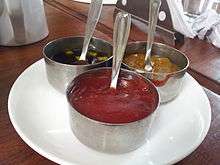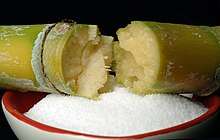Cheong (food)
Cheong (청; 淸) is a name for various sweetened foods in the form of syrups, marmalades, and fruit preserves. In Korean cuisine, cheong is used as a tea base, as a honey-or-sugar-substitute in cooking, as a condiment, and also as an alternative medicine to treat the common cold and other minor illnesses.[1][2][3]
.jpg) A jar of yuja-cheong | |
| Place of origin | Korea |
|---|---|
| Associated national cuisine | Korean cuisine |
| Similar dishes | |
| Korean name | |
| Hangul | 청 |
|---|---|
| Hanja | 淸 |
| Revised Romanization | cheong |
| McCune–Reischauer | ch'ŏng |
| IPA | [tɕʰʌŋ] |
Originally, the word cheong (청; 淸) was used to refer to honey in Korean royal court cuisine.[4] The name jocheong (조청; 造淸; "crafted honey") was given to mullyeot (liquid-form yeot) and other human-made honey-substitutes.[5][6] Now, honey is rarely called cheong in Korean, but is instead called kkul (꿀), which is the native (non-Sino-Korean) name for honey. The name kkul was used in the past, outside the royal court.
Varieties
- Jocheong (조청; "crafted honey")
- mullyeot (물엿; liquid yeot) or rice syrup
- corn syrup
- Maesil-cheong (매실청; "plum syrup")
- Mogwa-cheong (모과청; quince preserve)
- Mucheong (무청; radish syrup)
- Yuja-cheong (유자청; yuja marmalade)
Maesil-cheong
Maesil-cheong (매실청; 梅實淸, [mɛ.ɕil.tɕʰʌŋ]), also called "plum syrup", is an anti-microbial syrup made by sugaring ripe plums (Prunus mume). In Korean cuisine, maesil-cheong is used as a condiment and sugar substitute. The tea made by mixing water with maesil-cheong is called maesil-cha (plum tea).
It can be made by simply mixing plums and sugar together, and then leaving them for about 100 days.[7] To make syrup, the ratio of sugar to plum should be at least 1:1 to prevent fermentation, by which the liquid may turn into maesil-ju (plum wine).[8] The plums can be removed after 100 days, and the syrup can be consumed right away, or mature for a year or more.[7]
Mogwa-cheong
Mogwa-cheong (모과청 [mo.ɡwa.tɕʰʌŋ]), also called "preserved quince", is a cheong made by sugaring Chinese quince (Pseudocydonia sinensis). Either sugar or honey can be used to make mogwa-cheong.[9] Mogwa-cheong is used as a tea base for mogwa-cha (quince tea) and mogwa-hwachae (quince punch), or as an ingredient in sauces and salad dressings.[10][11]
Yuja-cheong
Yuja-cheong (유자청, [ju.dʑa.tɕʰʌŋ]), also called "yuja marmalade", is a marmalade-like cheong made by sugaring peeled, depulped, and thinly sliced yuja (Citrus junos). It is used as a tea base for yuja-cha (yuja tea), as a honey-or-sugar-substitute in cooking, and as a condiment.[12][13][14]
Gallery
.jpg) Jocheong (rice syrup)
Jocheong (rice syrup)_(prunus_mume).jpg) Maesil-cheong (plum syrup)
Maesil-cheong (plum syrup)_preparation_(Prunus_mume).jpg) Preparing maesil-cheong
Preparing maesil-cheong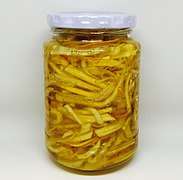 Mogwa-cheong (preserved quince)
Mogwa-cheong (preserved quince)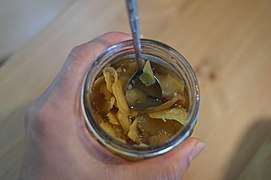 Saenggang-cheong (preseved ginger)
Saenggang-cheong (preseved ginger)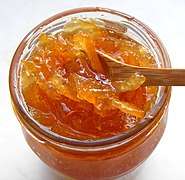 Yuja-cheong (preserved yuja)
Yuja-cheong (preserved yuja)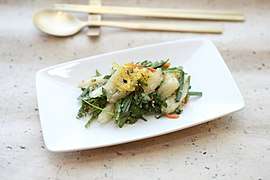 Deodeok-yuja-salad, a lance asiabell root salad with yuja-cheong-based dressings
Deodeok-yuja-salad, a lance asiabell root salad with yuja-cheong-based dressings
References
- Ro, Hyo Sun (1 February 2017). "Home cooking for Korean food: Sataejjim (slow cooker braised beef shank)". The Straits Times. Retrieved 7 February 2017.
- Baek, Jong-hyun (23 April 2016). "A taste of Korea with three regional delights". Korea JoongAng Daily. Retrieved 7 February 2017.
- 배, 수빈 (10 December 2016). "[지금이 제철] 추울 때 진가 발휘하는 '청(淸)'". MBC News Today (in Korean). Retrieved 7 February 2017.
- "cheong" 청. Standard Korean Language Dictionary (in Korean). National Institute of Korean Language. Retrieved 17 February 2017.
- "jocheong" 조청. Standard Korean Language Dictionary (in Korean). National Institute of Korean Language. Retrieved 17 February 2017.
- "mullyeot" 물엿. Standard Korean Language Dictionary (in Korean). National Institute of Korean Language. Retrieved 17 February 2017.
- Baek, Jong-hyun (23 April 2016). "A taste of Korea with three regional delights". Korea JoongAng Daily. Retrieved 17 December 2016.
- 한, 동하 (1 June 2016). "청(淸)과 발효액은 어떻게 다를까?". Kyunghyang Shinmun (in Korean). Retrieved 18 December 2016.
- 김, 상현. "Mogwa-cha" 모과차. Encyclopedia of Korean Culture (in Korean). Academy of Korean Studies. Retrieved 22 June 2017.
- "Mogwa-cha" 모과차. Doopedia (in Korean). Doosan Corporation. Retrieved 22 June 2017.
- "Mogwa-hwachae" 모과화채. Korean Traditional Knowledge Portal (in Korean). Retrieved 22 June 2017 – via Naver.
- "yuja-cheong" 유자청. Standard Korean Language Dictionary (in Korean). National Institute of Korean Language. Retrieved 20 June 2017.
- Liu, Jamie (24 October 2014). "Trend Watch: Asian Spirits and Cocktail Ingredients". Eater DC. Vox Media. Retrieved 20 June 2017.
- Joo, Judy (17 May 2016). "Citron Tea Posset". The Daily Meal. Retrieved 5 January 2017.
External links

